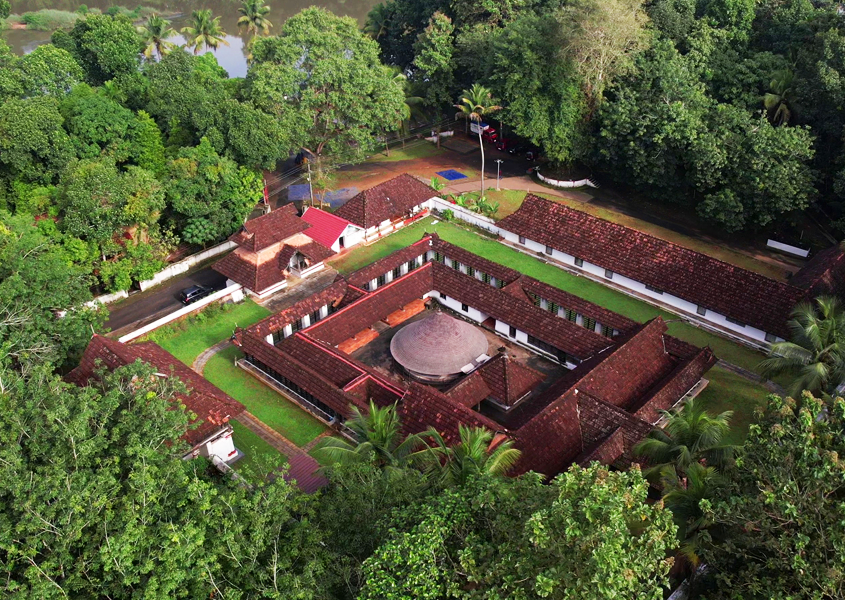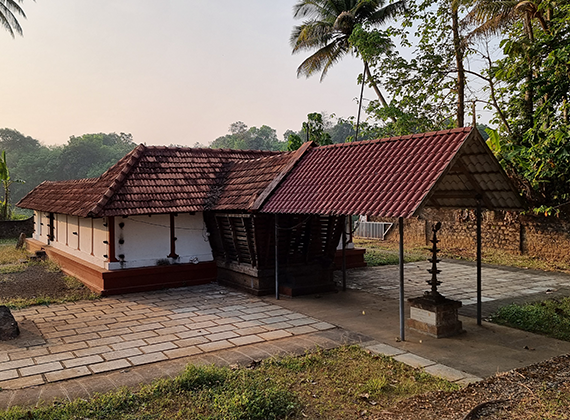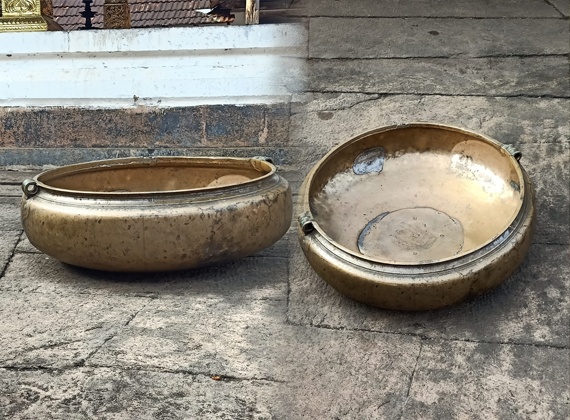
The Ooramana Sri Narasimha Swamy Temple and the Sri Dharmasastha Temple, located in the village of Ooramana, are among the ancient temples in Kerala. Under the administration of these temples, about one kilometer to the north is the Shivali Sri Subrahmanya Swamy Temple, and three kilometers to the south is the Valloor Srikrishna Swamy Temple. Located 13 kilometers from Muvattupuzha town, these temples are situated on the banks of the Muvattupuzha river in the scenic Ooramana village in the Ramamangalam panchayat, with the Sri Narasimha Swamy Temple and the Sri Dharmasastha Temple facing eastward. For many years, three families (three Manakals) have been managing these temples. Previously, the temple used to collect over 3000 paras (a traditional measure) of rice and nearly 2000 rupees as rent. However, after the land reforms in 1957, the temple faced a shortage of funds, resulting in its decline and degradation. Nonetheless, 19 years ago, the villagers formed a committee called the Ooramana Temple Protection Committee to rejuvenate the temple, leading to the regular conducting of daily rituals and annual festivals. Since then, the temple has been maintained with regular rituals and vibrant annual celebrations. With prayers for the blessings of Sri Dharmasastha and Sri Narasimhamurthy for the prosperity and well-being of everyone, these are the details gathered about the temple.

The Narasimha Swamy Temple is said to be over 3000 years old. The idol, originally made from anjanashila (a type of stone), has since been crafted in panchaloha (an alloy of five metals). According to legend, Parashurama, while traveling along the seashore, discovered a full-sized idol resembling Lord Vishnu. In search of a suitable place to install it, he wandered through many locations before arriving at a serene and beautiful place known as Ooramanam. At this site, he observed extraordinary scenes: natural enemies such as mongoose and snake, lion and deer, frog and snake, all coexisting peacefully. Recognizing this as a suitable location, he installed the sacred idol at what is now the temple. Over time, the area previously known as Ooramanam expanded and contracted to become today's Ooramana. In ancient times, Ooramana had 72 manas (manors), filled with all kinds of prosperity and grandeur. According to local lore, the reason for their destruction is attributed to the curse of Narasimha Swamy. Once, a Brahmin traveler from a distant land arrived in Ooramana on foot from the east in the evening, driven by extreme hunger. He went to each of the manors in the eastern part of the area, begging for food, but none provided him with any. When he reached the last manor and explained his plight, they directed him to the temple, suggesting that he might find food there. By the time he reached the temple, the night puja was over, the temple was locked, and the priests were asleep. He woke them up, but they told him that they couldn't provide food then and suggested he return after the noon puja the next day. Disheartened, the Brahmin went to the river to complete his rituals and then rested in the temple's outer courtyard, where he fell asleep from exhaustion and hunger. Suddenly, a tall man appeared and woke him up, asking about his situation. After hearing his story, the man assured him that he would find a way and led him to a granary, showing him a pot of rice and telling him to eat. When the Brahmin mentioned that there was no light, the man instructed him to face east while eating and provided him with a vessel of water. However, after eating, the Brahmin looked around and couldn't find the man who helped him. Astonished, he stepped outside with the pot of rice and saw a bright light coming from the eastern direction. The Brahmin realized that he had eaten by the light caused by the burning of the same manors that had refused him food. He then understood that the man who had fed him was none other than Narasimha Swamy himself. The next morning, the priests found the Brahmin asleep in the outer courtyard, with the same rice pot that had been locked inside the temple's inner sanctum. The Brahmin explained the events of the previous night, including how he was guided to the granary, provided with food, and witnessed the light from the burning manors. From this incident, it became known that Narasimha Swamy was also the provider of food, gaining him the title "Annaprasadamurthy." The temple is spread across approximately one acre, featuring a circular shrine room with an outer courtyard, a two-story gopuram (tower) at the western entrance, a dining hall to the north, a two-story guesthouse to the south, and a central pathway with various rooms, including a mandapam (pavilion). Several areas like the gopuram, the guesthouse, and the mandapam contain intricate wood carvings. Though parts of the shrine have aged and deteriorated, the walls still feature beautiful murals. The Archaeological Department of Kerala has since taken over the preservation of this historic temple.

The Dharmasastha Temple is said to be approximately 800 years old. In ancient times, the Nambudiris of the Thirunavaya Yoga performed Vedic studies at the Thirunavaya Matham. The Brahmins in the Ooramana region were also part of this group. The Nambudiri from the southern Elayeriyam (currently known as Thekkinedam) in Ooramana used to stay at Thirunavaya for his Vedic studies. Later, he resided in Chamravattam while worshipping Shasta (Dharmasastha) and made it his permanent residence. During that period, the ruling authorities of the Ooramana region killed all the Brahmins in the area, eradicating the Brahmin lineage from Ooramana. However, due to the course of events, the ruling authorities themselves split into two factions and started warring against each other. In that battle, the Vattamkandam and Potanikat factions united to defeat their opposing rulers. Since all the Brahmins in the area were killed, they brought Narayanan Nambudiri from Chamravattam to reside in Ooramana. People were sent to Chamravattam to bring him to Ooramana, but Narayanan Nambudiri, who worshipped Shasta at Chamravattam, had no interest in leaving. He expressed his distress to Shasta and cried about his troubles. Later, in his sleep, Shasta appeared in a dream, saying, "Take a stone from here to Ooramana, and I will follow." With some reluctance, he took a stone, covered his umbrella, and started his journey. By the next evening, he reached Ooramana, placed the stone and his umbrella by the riverbank, and went down to perform his rituals. After bathing, he returned to pick up the stone but found that it had become firmly rooted there. Realizing that Shasta had manifested himself at this spot, he offered his prayers from the east. Thus, the Shasta's darshan at Ooramana is oriented towards the east, unlike at Chamravattam, where the darshan faces west. Vattamkandam Karathakum gave a measure of rice for the naivedyam (sacred offering) to Shasta. Narayanan Nambudiri offered it, and thereafter, the Elayeriyam Nambudiri ensured that an amount of rice was given for the first naivedyam every day. This tradition continues today, with rice for naivedyam being provided by Thekkinedam. In those times, all the properties in the Ooramana region belonged to Narasimha Swamy. To create a territory for himself, Shasta instructed his bhoothaganas (followers) to divert the river flowing from the west through the space between the two temples. To accomplish this, they began constructing a dam on the north side of the river using large stones and soil, extending it to the middle of the river. When Narasimha Swamy saw this, he sent Devendra to the side of Sri Dharmasastha. Although it was midnight, Devendra took the form of a rooster and crowed, causing the bhoothaganas to panic, thinking that dawn was approaching. They dropped their work tools and fled towards the east, leading to the naming of the spots "Bhoothankettu" (where the dam was being built) and "Kottamuttithura" (where the tools fell). Later, under the mediation of Devendra, Sri Dharmasastha and Sri Narasimha Swamy reached an agreement that half of the offerings received at Ooramana temple would be shared with Shasta. This practice continues today, with the offerings being divided equally between the two deities. The Dharmasastha Temple does not have daily puja (ritual worship). Instead, only the naivedyam (sacred offering) is conducted, as only the tantri (high priest) has the authority to conduct puja, and there is no puja conducted by the santhi (temple assistant).

The Ooramana Temple possesses a very special utensil among its movable properties, known as the "Vidhi Warp" or "Kitty Warp." The story behind it is as follows: About 600 years ago, the work of cleaning and polishing utensils at the temple was carried out by elderly women. One day, while polishing a large pot at the temple entrance, an elderly woman accidentally let it slip, and the pot rolled into the river. Distressed by this loss, she called upon Sastha, as she believed it would be impossible to create a similar pot for the temple. Suddenly, from the exact spot where the pot had fallen, a medium-sized warp filled with gold emerged. Overjoyed, she took the warp and handed it over to the temple authorities, explaining what had happened. The unique characteristic of this warp is that when the primary offering at the Ooramana Temple, called "Chathushshatham," is made, a precise portion fills this "Kitty Warp." To this day, this warp is used exclusively to offer "Chathushshatha Payasam" to Sastha. Moreover, this warp has a particular trait—it doesn't warp in any direction. Unlike typical warps that have a natural curve or bend, this warp remains straight, giving it the name "Vidhi Warp." To date, there isn't a clear consensus on what metal it's made from, with opinions ranging from lead, copper, and brass to mixed metals. During the temple's prosperous times, five daily rituals were conducted: Ushapuja, Ethrathu Puja, Panthiradi Puja, Uchapuja, and Athazhapuja. However, with a decrease in revenue and increasing challenges, many of these rituals ceased. In the past, the offering for one ritual used to be 12 measures of rice, but now it's reduced to a single measure. Currently, the temple conducts three daily pujas: Ethrathu Puja, Uchapuja, and Athazhapuja, with a lamp lighting ceremony (Deepaaradhana) in both temples. Every month, on the Thiruvonam day, Narasimha Swamy is given a milk abhishekam, and on Uthram day, Sastha receives a ghee abhishekam. In addition, annual events such as Nira-Puthiri, Vishu-Kani, and Vidyarambham are celebrated, along with the festival held on Thiruvonam day in the Malayalam month of Meenam, which is dedicated to Lord Narasimha Swamy. The descendants of those who moved away from the area in ancient times are now returning to their roots and making offerings here. The primary offerings at the temple include Ellukizhi, Karikk Abhishekam, Palabhishekam, Pazham Nivedyam, along with other payasam varieties like Neipayasam, Chathushshatham, and Nalikera Tutikkal for Sastha. These rituals are currently being practiced, with the temple receiving support from the local community and devotees.